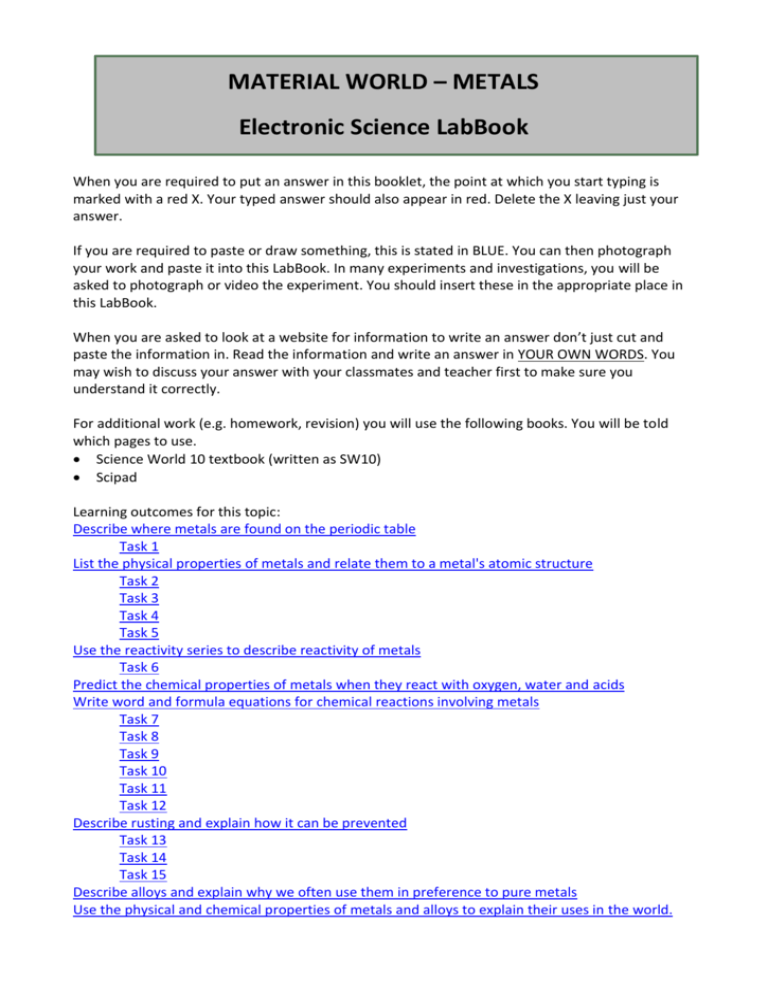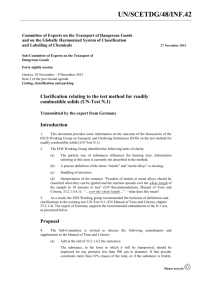File - WGHS Junior Science
advertisement

MATERIAL WORLD – METALS Electronic Science LabBook When you are required to put an answer in this booklet, the point at which you start typing is marked with a red X. Your typed answer should also appear in red. Delete the X leaving just your answer. If you are required to paste or draw something, this is stated in BLUE. You can then photograph your work and paste it into this LabBook. In many experiments and investigations, you will be asked to photograph or video the experiment. You should insert these in the appropriate place in this LabBook. When you are asked to look at a website for information to write an answer don’t just cut and paste the information in. Read the information and write an answer in YOUR OWN WORDS. You may wish to discuss your answer with your classmates and teacher first to make sure you understand it correctly. For additional work (e.g. homework, revision) you will use the following books. You will be told which pages to use. Science World 10 textbook (written as SW10) Scipad Learning outcomes for this topic: Describe where metals are found on the periodic table Task 1 List the physical properties of metals and relate them to a metal's atomic structure Task 2 Task 3 Task 4 Task 5 Use the reactivity series to describe reactivity of metals Task 6 Predict the chemical properties of metals when they react with oxygen, water and acids Write word and formula equations for chemical reactions involving metals Task 7 Task 8 Task 9 Task 10 Task 11 Task 12 Describe rusting and explain how it can be prevented Task 13 Task 14 Task 15 Describe alloys and explain why we often use them in preference to pure metals Use the physical and chemical properties of metals and alloys to explain their uses in the world. Task 16 Task 17 Task 18 Describe where metals are found on the periodic table Task 1 Metals are found on the X side of the Periodic Table List the physical properties of metals and relate them to a metal's atomic structure Metals have similar physical qualities. Task 2 Define the following physical properties: Conduction (thermal and electrical): X Density: X Ductility: X High melting and boiling point: X Lustre: X Malleability: X Sonority: X Strength: X Task 3 Watch this video. https://www.youtube.com/watch?v=d-iqaXSCKUghttps://www.youtube.com/watch?v=diqaXSCKUg Describe which properties would you look for in metals and how would you check for them. X Task 4 Complete Scipad p. 48-49. All metals have a similar physical structure as shown in the picture Task 5 The metal ions are held by very strong forces of attraction. This means that the metal ions will be held together tightly and it requires lots of energy to break them apart. List the physical properties that can be explained using this fact. X The metal ions have a high atomic mass and are packed together tightly into a small amount of space Which physical property is explained using this fact? X The free electrons can move between metal ions and can carry or reflect energy as they move. List the physical properties that can be explained using this fact. X Use the reactivity series to describe reactivity of metals The basic reactivity series will be given in the exam/test for the following metals: Na, Ca, Mg, Zn, Al, Fe, Cu, Au Task 6 Name a metal that will: React with water, acid and oxygen: X React with acid and oxygen but not with water: X Only reacts with oxygen: X How could you tell a piece of magnesium from a piece of lithium as they both look the same: X Predict the chemical properties of metals when they react with oxygen, water and acids Write word and formula equations for chemical reactions involving metals Metal with oxygen General formula: Metal + oxygen metal oxide Examples Magnesium + oxygen magnesium oxide Aluminium + oxygen aluminium oxide Task 7 Watch video clip and write your observations: https://www.youtube.com/watch?v=hQyJIxiSvUA X Complete Scipad p. 54-55. Metal with water General formula: Metal + water metal hydroxide + hydrogen Examples (demonstrations only) Sodium + water sodium hydroxide + hydrogen Calcium + water calcium hydroxide + hydrogen Task 8 Watch video clips and write your observations: https://www.youtube.com/watch?v=uixxJtJPVXk https://www.youtube.com/watch?v=B2ZPrg9IVEo X Metal with acids General formula: Metal + acid --> metal salt + hydrogen Examples Hydrochloric acid + magnesium --> magnesium chloride Sulfuric acid + zinc --> zinc sulfate Task 9 Watch the video and write your observations: https://www.youtube.com/watch?v=ECmNO0VMSgo X Complete Scipad p. 52/53 and 56/57 in. Note: Review gas tests in this unit, as H2 and CO2 are produced in acid reactions. Read SW10 p.167168 and p. 171. Four different metals are added to hydrochloric acid as shown in the diagram below. Task 10 Sort metals according to reactivity from the most to the least reactive: X Write word and chemical equations for reaction of each metal with hydrochloric acid: Calcium X Copper X Zinc X Magnesium X Task 11 Do the practical on p.168-169 of Science World 10 textbook (“Making Hydrogen”) and answer questions on p.169. Task 12 Do the practical on p.172 of Science World 10 textbook: “Making Carbon Dioxide”. Describe rusting and explain how it can be prevented Corrosion is a slow chemical reaction of metals in which their metallic structure is destroyed. Iron and its alloys react with oxygen in the presence of water which is called rusting. All metals corrode, however only the corrosion of iron is called rusting. Rust is a chemical compound of iron oxide. As a consequence the metal structure is destroyed and therefore it is not desirable process on building structures and machinery. You need to know about rusting of iron and how it is prevented by making barriers for oxygen (paint, rubber, oil etc.), by galvanising and by presence of sacrificial metal. Task 13 Describe rusting: X Rusting practical: https://www.youtube.com/watch?v=XMr4vse7Ybo Perform the practical and complete Scipad p. 58-59. Task 14 Explain the results of rusting experiment shown below? X Task 15 Explain how rusting can be prevented by describing four different methods and give example for each: 1X 2X 3X 4X Discuss what the following experiment is trying to investigate. What results do you expect to observe? X Describe alloys and explain why we often use them in preference to pure metals Use the physical and chemical properties of metals and alloys to explain their uses in the world. The different properties of metals determine how we use them. The following links are showing videos about extremely important metals: 1. Making an Axe from Iron Ore https://www.youtube.com/watch?v=vWxs7ZV5Ly8 2. Making History - Malachite & Copper https://www.youtube.com/watch?v=_OrBw4L490Y 3. Making History - Bronze https://www.youtube.com/watch?v=biHJaYWWIzM Task 16 Complete the following table after watching all three videos: What I already knew about it: What I have learnt new: What I found very interesting: 1. 1. 1. 2. 2. 2. 3. 3. 3. How do we choose what metals to use for different functions? Metals are used in a variety of places, which is dependent upon their physical properties. Alloys are special mixtures of two or more metals. They have different physical and chemical properties to the metals which make them and this determines their uses. Task 17 Describe alloys and explain why we often use them in preference to pure metals. X Task 18 Complete Scipad p. 50-51. EXTENSION Possible assignment: Research the use of alloys in construction in the modern world.







